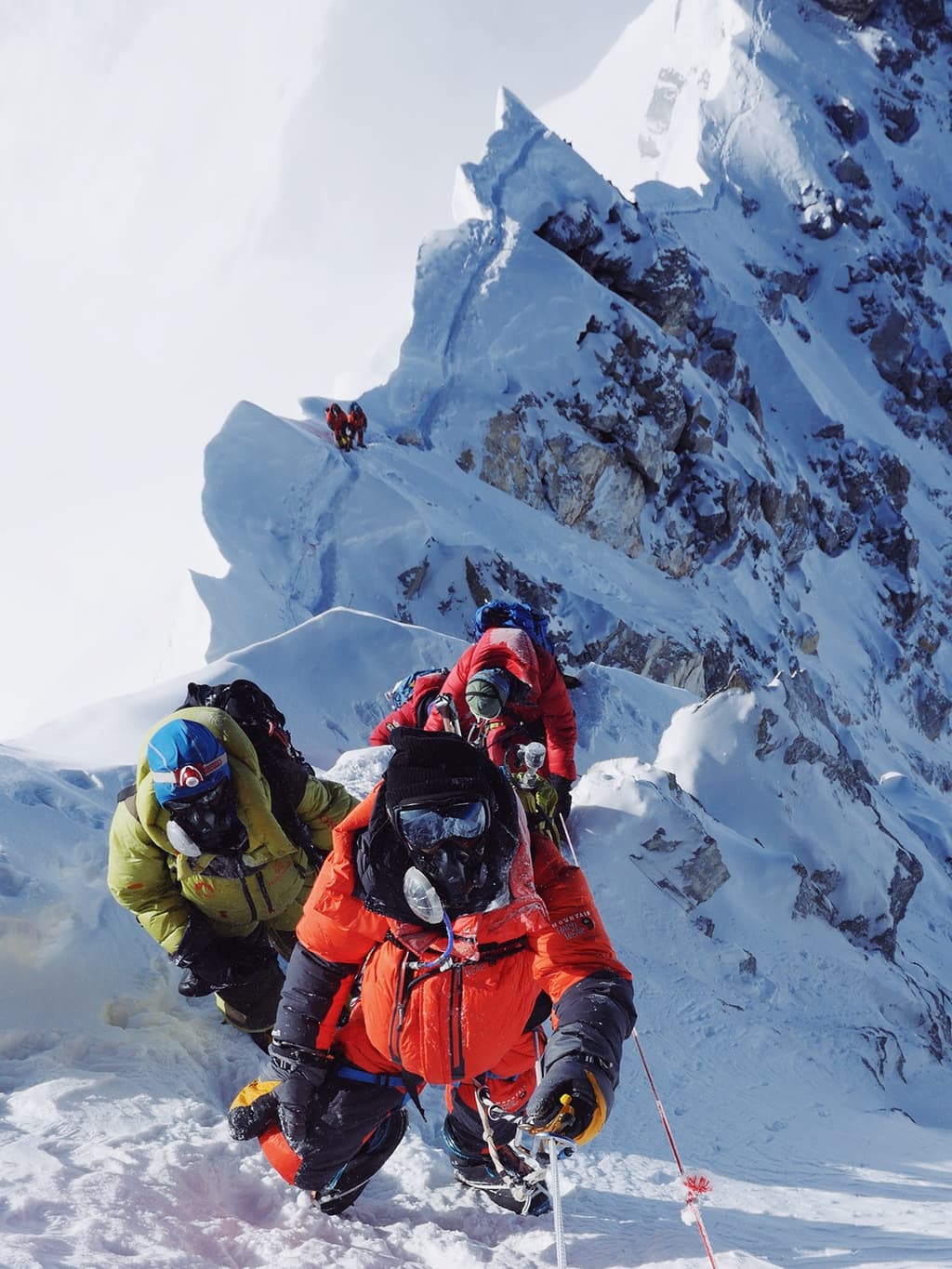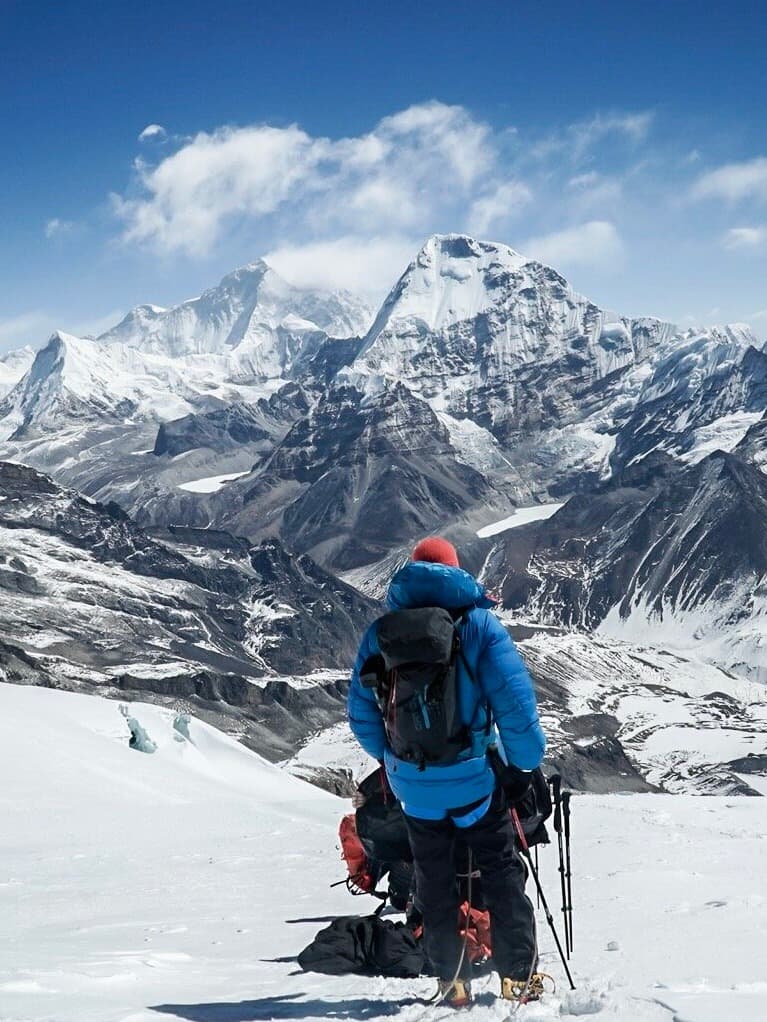Altitude sickness, referred to as acute mountain sickness (AMS), is a notable health issue that may come into play during high-elevation endeavors and usually occurs at elevations above 2,500 m (8,200 ft). With increasing elevation, the human body’s ability to acclimatize to declines in oxygen availability is greatly compromised, and manifests through symptoms such as; headache, nausea, dizziness, and fatigue. The best prevention against altitude sickness is through acclimatization, which means ascending gradually to aid the body in adapting to decreased barometric pressure to maximize physiological acclimatization. Acclimatization strategies include ascending slowly, taking rest days, and drinking plenty of fluids; all of which can improve oxygen transport and utilization in the body. Additionally, understanding the role of individuality in susceptibility to altitude illness can help in expedition planning; age, fitness level, and previous experiences at elevation will greatly affect how well an individual acclimatizes. At times pre-acclimatization trainings and medications may be utilized to supplement increasing protection against AMS. With that said, it is paramount to have a strong understanding altitude sickness and acclimatization principles to exude the safety of the team and the success of any high-altitude adventure, and get on with the expedition with the potential to embrace the the challenges and rewards of mountainous environments.
As adventure seekers, whether experienced climbers or simply passionate trekkers, we are often pursuing the experience of being at high altitude. The stunning views, the beautiful sense of solitude, and the sheer effort of switching from valley to summit create immense attraction to high-altitude adventures. Nevertheless, these experiences also bring their own risks, specifically altitude sickness. Also called acute mountain sickness (AMS), this can cause serious effects on health and safety. Knowing the causes, symptoms, prevention, and treatment are an important part of ensuring a successful, enjoyable expedition.
Understanding Altitude Sickness

Altitude sickness occurs when you ascend to elevations typically above 8,000 feet (approximately 2,400 meters) without acclimatization. As we rise in altitude, the air pressure decreases, resulting in less oxygen available for our bodies. This decrease affects physiological responses and can lead to a variety of symptoms ranging from mild to life-threatening.When embarking on high-altitude expeditions, such as trekking or mountaineering, one of the most important things to consider is altitude sickness. This condition, also known as acute mountain sickness (AMS), occurs when your body has difficulty adjusting to the lower oxygen levels at higher altitudes. Understanding the causes, prevention methods, and management strategies for altitude sickness is crucial to ensure a safe and successful adventure.
Types of Altitude Sickness
Understanding these types and their symptoms is crucial for identifying altitude sickness early and addressing it effectively.
-
Acute Mountain Sickness (AMS) is the most prevalent type of altitude sickness. It can onset within hours of a rapid ascent to elevations typically above 2,500 meters (8,200 feet). Symptoms of AMS include headache, nausea, dizziness, fatigue, and sleep disturbances. Most individuals recover from AMS with rest and gradual acclimatization.
-
High-Altitude Pulmonary Edema (HAPE) is a more serious condition that arises due to fluid accumulation in the lungs, impeding adequate respiratory function. Symptoms of HAPE include shortness of breath, persistent cough, and a feeling of suffocation, especially while resting. Immediate descent and medical intervention are crucial for those experiencing HAPE.
-
High-Altitude Cerebral Edema (HACE) represents the most severe and rarest form of altitude sickness. This condition occurs when excess fluid builds up around the brain. Symptoms include a severe headache, confusion, decreased coordination, and, in extreme cases, loss of consciousness. HACE is considered a medical emergency, necessitating urgent descent and medical attention.
This condition manifests in various forms, each with distinct symptoms and severity.Awareness and recognition of these types of altitude sickness are essential for individuals planning to traverse high altitudes. Proper acclimatization strategies and understanding symptoms can significantly mitigate risks associated with this potentially life-threatening condition.
Recognizing the Symptoms
Altitude sickness, also known as acute mountain sickness (AMS), occurs when it is difficult for your body to adjust to the higher altitude due to low oxygen. The symptoms can be from mild discomfort to severe and life-threatening conditions. It is better to learn about symptoms beforehand to be prepared to deal with altitude sickness. Symptoms can be varied among climbers and trekkers. It can help you prevent further progress of altitude sickness to serve forms which can be life threatening.You can see following symptoms when affected by altitude sickness.
Mild Symptoms of Altitude Sickness (AMS)
These are the most common symptoms experienced at elevations above 8,000 feet (2,400 meters):
- Headache: Often described as a dull ache that increases in intensity with elevation.
- Nausea and Vomiting: These symptoms may arise due to decreased oxygenation and changes in body fluid composition.
- Fatigue: A profound sense of tiredness that is disproportionate to the exertion level.
- Dizziness: A feeling of lightheadedness or unsteadiness.
- Insomnia: Unusual difficulty in sleeping, particularly in new environments.
- Loss of appetite: Difficulty in eating or no desire for having meals.
Severe Symptoms of Altitude Sickness
Severe altitude sickness can lead to life-threatening conditions like HAPE (High Altitude Pulmonary Edema) and HACE (High Altitude Cerebral Edema).
High Altitude Pulmonary Edema (HAPE)
- Extreme shortness of breath, even at rest.
- Coughing, often with frothy or pink sputum.
- Chest tightness or congestion.
- Rapid heartbeat and fatigue.
High Altitude Cerebral Edema (HACE)
- Severe headache that does not subside.
- Loss of coordination, difficulty walking, or clumsiness.
- Confusion, irritability, or changes in behavior.
- Drowsiness or loss of consciousness.
Risk factor of Altitude Sickness
Altitude sickness, also known as acute mountain sickness (AMS), poses a significant threat to individuals ascending to high elevations. Several factors contribute to the likelihood of experiencing this condition, and understanding them is crucial for safe travel in mountainous regions.Understanding these risk factors helps inform travelers on how to prepare for trips in elevated terrains.
-
Rapid Ascents: One of the primary risks associated with altitude sickness is rapid ascents. Traveling quickly to high altitudes does not allow the body sufficient time to acclimatize to the decreased oxygen levels. This lack of acclimatization can lead to a range of symptoms, from mild headaches and nausea to severe complications. It is advisable to ascend gradually, allowing the body to adapt to changing environmental conditions.
-
Previous Altitude Sickness:A history of altitude sickness significantly heightens the risk of experiencing similar symptoms in the future. Individuals who have suffered from AMS in the past may find that their bodies are less equipped to handle subsequent elevations. Awareness of this history is essential for planning future excursions to high altitudes.
-
Age and Physical Fitness: While altitude sickness can affect individuals of any age or fitness level, younger individuals and those who are physically fit often acclimatize more effectively. However, it is important to note that this is not a definitive rule. Factors such as individual physiology and previous experiences at high altitudes can also play a significant role in one's ability to adapt.
-
Pre-existing Health Conditions: Individuals with pre-existing respiratory or cardiovascular conditions may face an increased risk of altitude sickness. The reduced oxygen levels at high altitudes can exacerbate these conditions, leading to severe health complications. It is crucial for those with such health issues to consult with a healthcare professional before embarking on high-altitude travel.
So by understanding the multifaceted risks associated with altitude sickness is vital for anyone planning to travel to elevated terrains. By taking precautions and being mindful of personal health factors, climber and trekkers can enhance their safety and enjoyment while exploring the heights of the world.
Strategies for Preventing Altitude Sickness
Prevention is always better than cure, especially concerning altitude sickness. Here are key strategies to minimize risks:
-
Gradual Ascent: The most important element in avoiding altitude sickness is a gradual ascent.Give your body sufficient time to adapt to the lower oxygen levels found at higher altitudes.Limit yourself to no more than 1,000 feet (300 meters) of elevation gain daily.Think about adding more rest days to your schedule, particularly if you are ascending quickly or noticing any altitude sickness symptoms.
-
Acclimatization: Include rest days in your plan to enable your body to completely adjust to the altitude.A commonly accepted guideline is to schedule a rest day for every 3,000 feet (914 meters) of climbing.During your rest days, partake in light activities such as walking or gentle stretching, but refrain from intense exerciseHydration is Key: Maintaining proper hydration is essential in preventing altitude sickness. At higher elevations, the body loses water more quickly due to elevated respiration rates and evaporation.Consume ample fluids, especially water, to remain hydrated. Dehydration can worsen the symptoms of altitude sickness.Always carry a water bottle with you and drink water regularly throughout the day.If you are uncertain about the safety of your water source, consider using water purification tablets or a filter.Aim to drink at least 3 to 4 liters of water daily during your ascent. This not only helps prevent dehydration but also aids in overall blood circulation.A simple method to check your hydration level is by observing urine color. Pale yellow indicates sufficient hydration, while dark urine points to dehydration.
-
Nutrition matters: Food choices can greatly affect your body’s acclimatization capacity. Emphasize nutritious foods that enhance energy and overall health.Adopt a balanced diet rich in carbohydrates for energy and plentiful fluids. Focus on whole grains, fruits, and vegetables.Avoid excessive consumption of alcohol and caffeine, as they can lead to dehydration and disrupt your body’s acclimatization process.Eat smaller, more frequent meals throughout the day to sustain your energy levels.
-
Avoid Alcohol and Smoking: Alcohol and smoking can lead to dehydration and hinder your body’s acclimatization to elevated altitudes.Limit or eliminate alcohol intake, particularly in the days preceding and throughout your ascent.Avoid smoking, as it can further decrease oxygen levels in your bloodstream.
-
Listen to Your Body: Arguably the most vital aspect of preventing altitude sickness is to stay aware of your body’s signals. If you begin to notice symptoms, act promptly.Take note of how you feel. If you show any symptoms of altitude sickness, such as headache, fatigue, nausea, or trouble sleeping, descend immediately to a lower altitude.Do not disregard warning signs or overexert yourself.If symptoms worsen or you encounter severe symptoms, the safest approach is to descend to a lower elevation where oxygen levels are higher and seek medical attention without delay.Communicate with Your Team members can assist in addressing any concerns, facilitating collective support and awareness.
-
Medication and Supplements: Various medications may help in preventing or easing the symptoms of altitude sickness. Consult with a healthcare professional before your expedition.Acetazolamide (Diamox) this prescription medication can accelerate the acclimatization process by enhancing breathing and can be effective in relieving AMS symptoms.Medications like ibuprofen or acetaminophen can aid in managing headache symptoms linked to altitude sickness.
-
Physical Conditioning: Pre-expedition fitness is crucial for successfully completing high-altitude treks. Proper conditioning enables your body to handle the challenges of elevation.Participate in aerobic activities such as running, cycling, or swimming to improve cardiovascular fitness prior to your trip.Increasing strength through resistance workouts can help minimize fatigue during extended ascents.
By implementing these strategies, you can greatly lessen your chances of experiencing altitude sickness and experience a safe and successful high-altitude adventure.
Remedy for Altitude Sickness
Altitude sickness management emphasizes alleviating symptoms and avoiding complications while your body acclimatizes to elevated altitudes. For mild instances, the essential actions comprise resting, maintaining hydration, and taking over-the-counter analgesics. In more critical situations, like moderate to severe AMS, HAPE, or HACE, prompt descent to a lower elevation, obtaining medical assistance, and utilizing supplemental oxygen (when accessible) are vital. Timely intervention can aid in averting life-threatening scenarios and guaranteeing a secure recovery.Here's a breakdown of the treatment for different levels of severity:
For Mild AMS:
- Stop Ascending: The first step is to halt any further ascent until symptoms improve.
- Rest: Allow your body to acclimatize by resting and avoiding physical exertion.
- Hydrate: Drink plenty of fluids to help your body adjust and maintain hydration. Avoid alcohol and caffeine.
- Over-the-Counter Pain Relievers: If you experience headaches or muscle pain, you can take medications like ibuprofen or acetaminophen.
- Natural Remedies: Some local remedy can help to alleviate altitude such as Ginger tea can help with nausea and Garlic soup or chewing garlic may improve circulation.
For Moderate to Severe AMS, HAPE, or HACE:
- Descend Immediately: The most critical step is to descend to a lower altitude as soon as possible to help your body recover. This is especially important for severe symptoms of AMS, High Altitude Pulmonary Edema (HAPE), or High Altitude Cerebral Edema (HACE).
- Seek Medical Attention: If symptoms persist or worsen, seek medical help immediately. Medical professionals may administer treatments like oxygen therapy or medications.
- Supplemental Oxygen: If oxygen is available, it can help alleviate symptoms and prevent further complications. Supplemental oxygen is particularly helpful for HAPE and HACE.
High altitude expeditions are exciting adventures that create unique and memorable experiences. Nevertheless, altitude sickness can create challenges that need to be appropriately planned for, acknowledged, and managed. Using preventative techniques, recognizing symptoms early, and acting appropriately can provide the chance to enjoy the awe inspiring elevation of our planet while managing your health. Remember, the keys to a successful expedition are not necessarily in the destination, but rather in the process and how well-prepared you are to meet the accompanying challenges.
At Everest Sherpa Expedition, we provide advice, and develop an individualized acclimatization plan that works for you to take precautionary measures against altitude sickness. Our priority is your safety and success of your climbing is never hindered by altitude sickness, so that you can engage in the experience and the rewards of climbing and trekking. Proper nutrition, appropriate hydration, and sleep the evening before can be helpful. Your doctor can advise you if it is reasonable to consider taking altitude sickness medication( diamox). In extreme cases, when high-altitude pulmonary edema (HAPE) and high-altitude cerebral edema (HACE) are suspected, immediately alert for medical assistance and retreat downward, as to do otherwise might be considered a life threat. Preparation and recognition are important, so take the time to equip yourself with knowledge and resources before embarking on your altitude adventure. Enjoy your climb, respect the mountain, and prioritize your well-being for a fulfilling expedition experience.It offers opportunity for adventure and personal growth.
FAQs About Altitude Sickness and Prevention Strategies
Q: What is altitude sickness?
A: Altitude sickness, also known as acute mountain sickness (AMS), appear when your body struggles to adapt to lower oxygen levels at high altitudes. Symptoms like headaches, nausea, dizziness, and fatigue commonly seen. Trekkers starts to feel altitude sickness at elevations above 8,000 feet (2,400 meters). It can be riskier to ascend higher without proper Acclimatization.
Q: How can I prevent altitude sickness?
A: You can prevent it by proper rest at acclimatization days,staying hydrated, having nutritious meals and using medication like diamox with consulting with doctor. And avoid consuming alcohol and smoking as it can accelerate the heartbeat making breathing difficult.
Q: What should I do if I experience altitude sickness?
A: Stop ascending and rest at your current altitude. If symptoms worsen, descend to a lower altitude immediately. In severe cases, seek medical attention and consider oxygen therapy.
Q: What is acclimatization?
A: Acclimatization is the process of allowing your body to adapt to lower oxygen levels at high altitudes. It involves ascending gradually, taking rest days, and following the "climb high, sleep low" strategy.
Q: Can children and older adults get altitude sickness?
A: Yes, altitude sickness can affect anyone, regardless of age, fitness level, or experience. Proper acclimatization and gradual ascent are crucial for all age groups.
Q: Is there medication for altitude sickness?
A: Yes, medications like Acetazolamide (Diamox) can help prevent and reduce symptoms of altitude sickness. Consult a doctor before use. In severe cases, Dexamethasone may be used under medical supervision.
Q: Can fitness levels prevent altitude sickness?
A: While physical fitness helps with the physical demands of trekking or climbing, it does not prevent altitude sickness. Proper acclimatization is essential for everyone, regardless of fitness level.
Q: How much water should I drink at high altitudes?
A: Drink at least 3-4 liters of water daily to stay hydrated. Avoid caffeinated and alcoholic beverages, as they can contribute to dehydration.
Q: How long does it take to acclimatize?
A: Acclimatization typically takes 1-3 days at each altitude level. The process varies depending on the individual and the altitude.
Q: Can altitude sickness be fatal?
A: Yes, severe forms of altitude sickness, such as HAPE and HACE, can be life-threatening if not treated promptly. Immediate descent and medical intervention are critical.
Q: Can I use oxygen to prevent altitude sickness?
A: Supplemental oxygen can help alleviate symptoms in emergencies, but it is not a substitute for proper acclimatization. Use it only as part of a comprehensive altitude sickness management plan.
Q: What is the "climb high, sleep low" strategy?
A: This strategy involves ascending to a higher altitude during the day and descending to sleep at a lower altitude. It helps your body acclimatize more effectively.
If you need any further information, please contact us by email: [email protected], Phone: +977- 980 195 6248 (WhatsApp).


